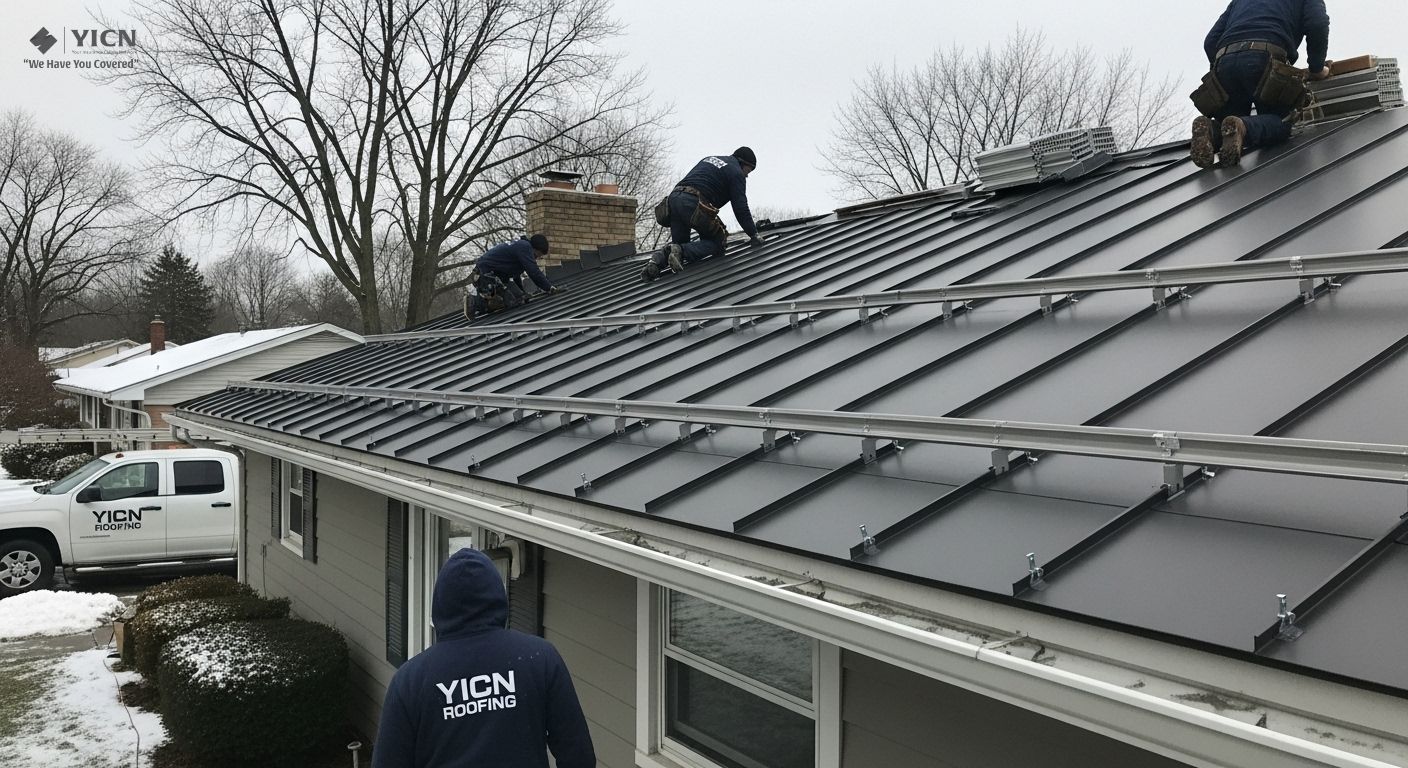
Ice dam resistant Standing Seam Metal Roof Installation on a flat to low slope in Bedford Heights
To prevent ice dams on flat to low slope roofs in Bedford Heights, install a mechanically seamed standing seam system with a double-lock seam, a continuous ice and water shield, and proper attic insulation and ventilation. These features create a watertight barrier, prevent heat loss that melts snow, and manage freeze-thaw cycles. Additional measures like snow guards, heated eave panels, and wide valley flashings ensure reliable drainage and long-term protection in Northeast Ohio’s harsh winters.
Why Traditional Roofs Fail in Bedford Heights Winters
The most homeowners don't realize - regular asphalt shingles and even some metal roofing systems just can't handle our Northeast Ohio winters on low-slope roofs. When snow piles up on a roof surface that's nearly flat, it doesn't slide off like it would on a steep roof pitch. Instead, it sits there, creating the perfect conditions for ice dams.
I remember working on a house near the Bedford Heights Community Center where the homeowner had tried heat cables on his old shingle roof. The meltwater would run down to the eaves, freeze again, and create even bigger ice dams. It was like putting a band-aid on a broken pipe.
The real problem happens when heat loss from your attic warms the roof deck. This melts the bottom layer of snow, creating water that flows down until it hits the cold eaves where it refreezes. On a flat roof or low-slope system, this water has nowhere to go quickly, so it backs up under whatever roofing material you have
Ice Dam Resistant Standing Seam Metal Roof Installation – Bedford Heights
To install an ice-dam resistant standing seam metal roof on a flat-to-low-slope building in Bedford Heights, follow these key steps:
Choosing the Right Panel Profile for Low Slopes
Panel Type | Best Use (Roof Slope & Conditions) | Key Benefits | Core Risks/Limitations | Ice-Dam Resistance | Maintenance Needs | Customer Tip |
Mechanically Seamed Standing Seam | Flat-to-low-slope: 1/4:12 to 3:12; harsh freeze/thaw; heavy snow loads | Maximum leak protection; seams are machine-folded 180°; compatible with full ice & water shield and wet-sealed seams; great for Bedford Heights winters | Higher upfront cost; requires skilled crew and a seaming machine; slower install | Excellent (best for ice dams when paired with ventilation + full underlayment) | Low; annual check of seams, snow guards, and penetrations | Best choice for long-term durability and no leaks. Ask for a double-lock seam and full-deck ice & water shield with in-seam sealant on very low slopes |
Snap-Lock Standing Seam (water-shedding) | Low slopes: 3:12+ recommended; good for typical homes without extreme ponding | Lowest upfront cost; easy to source; fast install | Not designed for hydrostatic conditions; risk on slopes under 3:12; not ideal for ice dam back-up | Moderate (better on steeper “low” slopes; add snow guards and heat cable at eaves) | Low-to-moderate; inspect clips and panel lock annually | Reliable and cost-effective with professional install. Verify your roof pitch meets manufacturer minimum (often 3:12). |
Exposed Fastened Panels (R-panel, AG-panel) | Slightly steeper low slopes: 3:12 or greater; garages, barns, budget projects | Lowest upfront cost; easy to source; fast install | Fasteners penetrate panel surface; gasket wear over time; more potential leak points | Fair (needs diligent fastener maintenance; not recommended for near-flat areas) | Higher; re-tighten/replace fasteners and washers every 5–10 years | Lower cost, but needs more upkeep and maintenance. Budget for periodic fastener and washer replacement. |
Corrugated / Ribbed Panels | Steeper low slopes: 4:12+; rustic/traditional aesthetics | Classic look; economical; lightweight | Not suited to flat or near-flat roofs; overlaps can leak under wind-driven rain or ice back-up | Fair-to-Poor on low slopes (use only on steeper roofs) | Moderate; monitor lap seams and edges | Affordable, but not suitable for flat or near-flat roofs. Choose only if your pitch is safely above 4:12. |
Ice and Water Shield: Your First Line of Defense
Most guys think ice and water shield is just for problem areas. Wrong. On flat-to-low-slope roofs dealing with ice dams, the entire roof deck needs protection.
We installed a fully adhered ice and water shield over the entire roof surface before any metal roofing went down. This self-adhering membrane becomes your backup water barrier when ice forces meltwater past the metal roof panels.
Sealant Strategy for Sub-Minimum Slopes
Here's where most metal roofing specialists mess up. Even with perfect mechanical seaming, slopes below 3:12 need additional sealant protection.
We used a wet-sealing process:
Applied 1/8-inch bead of non-curing sealant in each seam before panel installation
Added sealant at every panel clip location
Used Perme-2140 sealant that stays flexible through freeze-thaw cycles
This creates a dual-barrier system - mechanical seams handle normal water flow, sealant handles backup situations during severe ice dam events.
Ventilation: The Real Solution to Ice Dams
You can install the best metal roof system in the world, but if heat is escaping from your attic, you'll still get ice dams. The goal is maintaining a cold roof surface so snow doesn't melt and refreeze at the eaves.
For this project, we installed:
Continuous soffit vents along the entire eave line
Ridge venting with baffled design to prevent snow infiltration
CrossVent® roof deck ventilation to create airflow under the metal panels
The airspace between the metal roof and roof deck allows natural ventilation that keeps the roof surface temperatures consistent.
Snow Guards and Heat Management
Even with perfect ventilation, Northeast Ohio gets blizzards that dump massive snow loads. Snow guards aren't just about preventing avalanches - they help manage ice dam formation.
We installed Defender 6500 snow guards in a grid pattern across the entire roof plane. These hold snow in place so it melts gradually instead of sliding down to create ice blockages at the eaves.
For extra protection, we integrated self-regulating heat cables along the eave line and in the gutters. These only activate when temperatures drop below freezing and there's moisture present.
Seasonal Maintenance
Metal roofs are low-maintenance, but ice-dam resistant systems need attention:
Fall Preparation
Clean all gutters and downspouts
Check heat cable systems
Inspect sealant at seams and valley areas
Remove leaves and storm debris
Winter Monitoring
Watch for icicle formation at eaves
Keep snow loads below 3 feet if possible
Check attic temperatures during cold snaps
Spring Inspection
Look for sealant deterioration
Check panel expansion joints
Inspect gutters for ice damage
Why Low Slope Roofs in Bedford Heights Need Special Attention
Flat and low slope roofs don’t shed water like steep roofs. Water hangs out longer, freezes, expands, and works into seams. If you’re using the wrong roofing materials like asphalt shingles, you’re just asking for buckling, cracking, or mold.
With standing seam metal roofing, the whole point is a tight lock system. On a slope as low as 1/4:12, only a mechanical seamed system with double folds is safe. Snap-lock panels? Forget it. They’re not watertight enough for this weather.
In our Bedford Heights case, the home sat near a tree line. Leaves filled the gutters, snow cover was heavy, and the freeze-thaw cycle was brutal. Homeowners had already seen mildew on ceilings from past winters.
The Science Behind Ice Dam Resistant Metal Roofing
A proper ice-dam resistant standing seam metal roof installation on a flat-to-low-slope works completely different from traditional roofing systems. We use mechanically seamed panels that create a watertight barrier, not just a water-shedding surface.
Here's what makes it work:
Double-lock seaming - We use a seaming machine to create 180-degree folds that lock together mechanically. This isn't your typical snap-lock profile that relies on clips. The seams are literally folded and compressed together, making them virtually leak-proof even when water sits on them for extended periods.
Continuous ice and water shield - Under the metal panels, we install a self-adhering membrane across the entire roof deck. This acts like a second roof underneath your standing seam system. Even if ice forces water past the metal roofing, it can't penetrate into your home.
Proper slope engineering - While your roof might look flat, we create subtle slopes (minimum 1/4:12 pitch) that guide water toward downspouts without creating pooling areas where ice can form.
Standing Seam Metal Roof Installation with YICN Roofing
At YICN Roofing, we understand that the performance and durability of a low slope metal roof are only as strong as the quality of its installation. Our team specializes in precision seaming, secure sealing, and expert panel assembly, ensuring every project meets and exceeds manufacturer specifications. With years of hands-on experience and a commitment to industry best practices, we deliver roofing systems that are built to last. Choosing YICN Roofing means peace of mind—no leaks, no shortcuts, just superior craftsmanship that protects your property for decades.
YICN Roofing - Your Insurance Claims Network Available 24/7 | A+ BBB Rating | 100+ Satisfied Customers Phone: (216) 999-4342 | Email: yicnteam@gmail.com Website: https://www.yicnroofing.com/
About the Author: Kevin Stone , chairman and founder of YICN Roofing (Your Insurance Claims Network), Northeast Ohio's premier storm damage roofing contractor serving homeowners throughout Bedford Heights and the surrounding 30-mile radius. Operating from the company's headquarters at 5420 Mardale Ave, Bedford Heights, OH 44146, Kevin has transformed YICN Roofing into a top-rated roofing company with an A+ Better Business Bureau score and over 100 satisfied customers who trust his expertise for their most critical roofing needs.Since establishing YICN Roofing, Kevin has built a reputation that extends far beyond traditional roofing services. His comprehensive understanding of the insurance claims process, combined with decades of hands-on roofing expertise, has positioned YICN Roofing as the go-to contractor for Northeast Ohio homeowners facing storm damage, emergency repairs, and comprehensive roof restoration projects. Available 24 hours a day at (216) 999-4342,in Greater Cleveland area, including Bedford Heights and surrounding communities, faces some of the most demanding weather conditions in the Midwest. Throughout his career, Kevin has personally overseen thousands of roofing projects across Northeast Ohio, from emergency tarping services during severe storms to complete roof replacements for homes damaged by hail, wind, and ice. His experience spans residential neighborhoods in Bedford Heights, where older homes require specialized attention to maintain their architectural integrity, to newer developments in surrounding communities that benefit from modern roofing materials and installation techniques.
